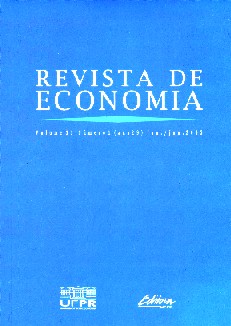O VALOR ECONÔMICO DE EXISTÊNCIA DO PARQUE NACIONAL DO JAÚ (AMAZONAS)
DOI:
https://doi.org/10.5380/re.v30i1.2009Keywords:
Parque Nacional do Jaú, valor de existência, valor econômico total, Método de Valoração Contingente, políticas ambientais, National Park of Jaú, existence value, total economic value, Contingent Valuation Method, environmental policies.Abstract
Nas últimas décadas, a discussão sobre a utilização do Valor de Existência (VE) na composição do Valor Econômico Total (VET) tem acentuado a necessidade da sua aplicação na formulação de políticas públicas ambientais. O seu uso compreende a avaliação de programas e projetos que incluem a busca do desenvolvimento sustentável. Políticas ambientais resultam em benefícios para alguns e em custos para outros. Freqüentemente, os custos de um programa na área ambiental são custos para a sociedade envolvida no programa. No caso das Unidades de Conservação (UC) de uso indireto dos recursos, tem sido difícil a quantificação dos benefícios sociais que essas áreas geram em razão dos diversos valores nelas existentes. Nesses casos, faz-se a avaliação de valores indiretos das funções dos ecossistemas. No presente estudo, foi empregado o Método de Valoração Contingente (MVC), por intermédio da aplicação de um questionário (survey) por meio eletrônico (e-mail). Como contexto, foi utilizado o Parque Nacional do Jaú (PNJ), e a população amostrada foi constituída da totalidade dos bolsistas em Produtividade em Pesquisa (PQ) do Conselho Nacional de Desenvolvimento Científico e Tecnológico (CNPq), os quais declararam uma Disposição a Pagar média no valor de R$ 2,12. Também foram avaliadas questões sobre percepção ambiental, conhecimento sobre os Parques Nacionais e dados socioeconômicos.
Abstract
In the last decades the quarrel on the use of the Existence Value (EV) in the composition of Total Economic Value (TEV) is accenting the necessity of its application in the formularization of environment public policies. Its use goes since the evaluation of programs and projects until the search of the sustainable development. Environment policies result in benefits for some and costs for others. Frequently, the costs of one program in the environmental a area are costs for the involved society in the program. In the case of the Conservation Units of indirect use of the resources, it has been difficult the quantification of the social benefits that these areas generate in reason of the diverse existing values. In these cases one becomes through the evaluation of indirect values of the functions of ecosystems. In the present study Method of Contingent Valuation was used (MCV), through the one application survey for half electronic (e-mail). As context was used the National Park of Jaú (NPJ), and the showed population was constituted of the totality of the scholarship holders in Productivity in Research (PR) of the National Council for Scientific and Technological Development (CNPq). The PR scholarship holders had arrived at an average Willing to Pay-WTP the value of R$ 2,12. Also partner-economic questions on ambient perception, knowledge on the National Parks and socio-economic data had been made.
Downloads
How to Cite
Issue
Section
License
By submitting a manuscript to this journal, authors agree with the following terms:
1. Authors retain copyright and grant the journal the right of first publication, with the work simultaneously licensed under the Creative Commons Attribution CC-BY License, which allows for the sharing of the paper while acknowledging authorship and initial publication in this journal.
2. Authors are granted the right to enter into additional and separate contracts aiming at the non-exclusive distribution of the version of the manuscript published in this journal (e.g., reproduction either in institutional repositories or as book chapters), with the acknowledgment of authorship and initial publication in this journal.





